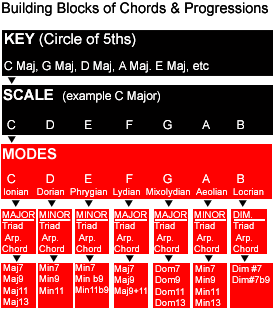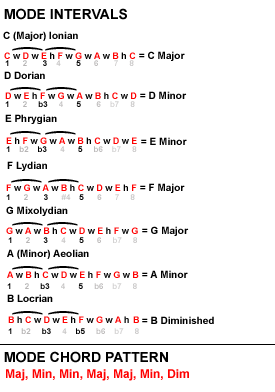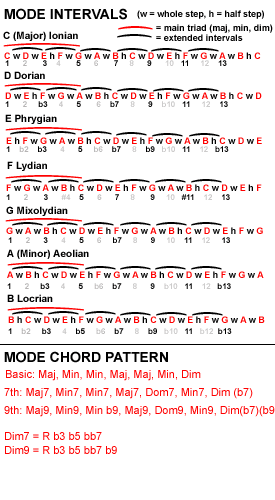| Lesson Subject:
Understanding Chords |
| What you learn:
Chord Progressions |
| Teacher: Michael Johnson |
Michael: Music, scales and chord
theory are
all built on patterns and formulas. It's like placing pieces of a puzzle
together and figuring how they all work together. Once you understand these formulas and
how they fit together you can figure out any chord or progression on your own,
and then you will be able to figure out songs on your own and how to write them
as well. In the prior lessons I have covered segments and formulas of this
puzzle. In this lesson we'll apply extended chords to various chord
progressions.

Michael:
First we will review the previous concepts
1. Breakdown of the SCALE into a basic TRIAD,
ARPEGGIO, & CHORD
2. Learning the CIRCLE OF 5THS
to establish the KEY (I. E: C Major: C D E F G A
B)
3. Learning how the SCALE breaks down into
MODES and how each of the MODES breakdown into basics of chords:
Part 1:
1. C D E F G A B can be broken into MODES
C Ionian:
C D E F G A B
D Dorian: D E F G
A B C
E Prygian: E F G A
B C D
F Lydian:
F G A B C D E and so on
Part 2:
C Ionian (Maj)
D Dorian (Min)
E Phrygian (Min)
F Lydian (Maj)
etc....
4. How the MODES breakdown into
extended chords (i. e. Dom9, Min11, Maj13.....)
Todd: What do the weird names
mean?
Michael:
They are Greek names, notice the modes
all have the same notes, but only a different order. Lyle Ronglien has a good CD
(Understanding Modes) just on modes. Now each of these individual MODES can each
be broken into TRIADS, ARPEGGIOS & CHORDS as well. These chords are what make up
a CHORD PROGRESSION, remember the order below:
1. KEY
2. SCALE
3. MODES
4.
CHORDS
5. CHORD PROGRESSION
Michael:
Everybody clear so
far?
coors:
yes
Todd:
kinda
luke: i
think
coors:
clear as a bell.
Michael: OK, here's a chart of the chords you can
play using each MODE:
Modes Chart

Todd: Are mode chords the same as regular
chords?
Michael: Yes
Todd, it's all based on the distance
of INTERVALS from the 1, 3 and 5 notes, that's where they come from, MAJOR,
MINOR.... OK, notice for the Major you have 1, 3, 5.... Minor 1, b3 5, and Dim
1, b3, b5.
Modes Chart
Extended

Michael:
OK, look at the patterns using the
scales and look at the formulas below, the important thing to UNDERSTANDING is
HOW they work together, and REMEMBERING the FORMULA below, in the KEY of C
MAJOR, what 7th chords can you use? Remember use the formula
below
Ralph:
cmaj7 dm7 em7 fmaj7 g7 am7 bdim7, its that easy
Michael:
Great Ralph! Do you all understand how Ralph
got that.
Glenn: yes
Michael:
There are Maj7 and one dom 7, dom7 = 7. OK here's the tab for each mode.
Michael:
In each of these tabs I play the SCALE (mode) in 2 octaves. The ARPEGGIO which
helps show what notes you can use and the CHORD. Here's the 2nd mode in the Key of C
Major - D Dorian.
Michael:
The mode works out to have a 1, b3, 5, b7 which = Dm7, here's the 3rd mode E
Phrygian.
Michael:
Notice the E Phrygian has a 1, b3, 5, b7 = Em7, here's the 4th mode F
Lydian:
Michael:
See how the F Lydian has the 1, 3, 5, 7 = F Maj7. The G Mixolydian has a 7th note
that is flatted in this scale, this make the chord a G Dom7
(G7).
Michael:
Now the A Aeolian (relative Minor).
Michael:
Notice the 1, b3, 5, b7 =
Am7. I'm just going through thru the
patterns, just keep remembering the formula I sent earlier: Maj7, Min7, Min7,
Maj7, Dom7, Min7, Dim (b7), here's the B Locrian.
Michael:
Here's how all the chords look
together, here's the simple part.
Michael:
OK, in this tab I play the basic 7th chords you can use in the KEY of C MAJOR
1 = C Maj7,
2 = D Min7,
3 = E Min7,
4 = F Maj7,
5 = G Dom7,
6 = A Min7,
7 = B Dim (b7)
Michael:
So let's make up a chord progression,
I'll play C Maj 7, F Maj7 and G7. Here's the first live sound clip,
Sound Clip 1
Michael:
See how I understand what chords I can
select? why don't one of you select a few chords for me to play; start either
from the C or Am. Using the chords you can select from: C
Maj7, D min7, E Min7, F maj7, G7, A Min7.
Todd: Because they were chosen from the basic 7th
patterns of the C Major mode? B Dim 7, D Min7 & F Maj
7
Michael:
Yes Todd, and you can mix and match any of
these combinations. Remember to start with either C or Am.
Todd:
Why?
Michael:
Because it generally sets the KEY of the
progression, not saying you can't start with something
else.
Todd: C Maj
7, F Maj 7, D Min 7 & B Dim (b7)
Michael:
Most songs all set up the key using the
first chord. Here's the next live clip.
Sound
Clip 2
Todd: Sounds like a sad love song, on a
rainy day.
Michael:
Well I hope this helps on how songs are
constructed from Keys and chord progressions. It's time for me to go, but, I'll
send out a few tabs showing how 9th chords are built. Here's the C
Maj9.
Michael:
The D Dorian and D m9, this
should give you an idea of the sound and positions.
Michael:
Here are some general rules; rock and
blues generally uses the major, minor, 7ths and 5 (power) chords. Jazz uses the 7ths,
9ths, dim, 11ths, 13ths etc, that's why these chords have a jazzy tone to them!
Well I hope this entire series has helped give you a better understanding of how
to build chord progressions so you can apply these formulas and concepts to
figuring out songs on your own and writing your own songs!
Todd: You don't
realize how far along your theory lessons have brought me, on Monday i had no
idea what theory was, thanks!!!
|
<< load notation from left
|